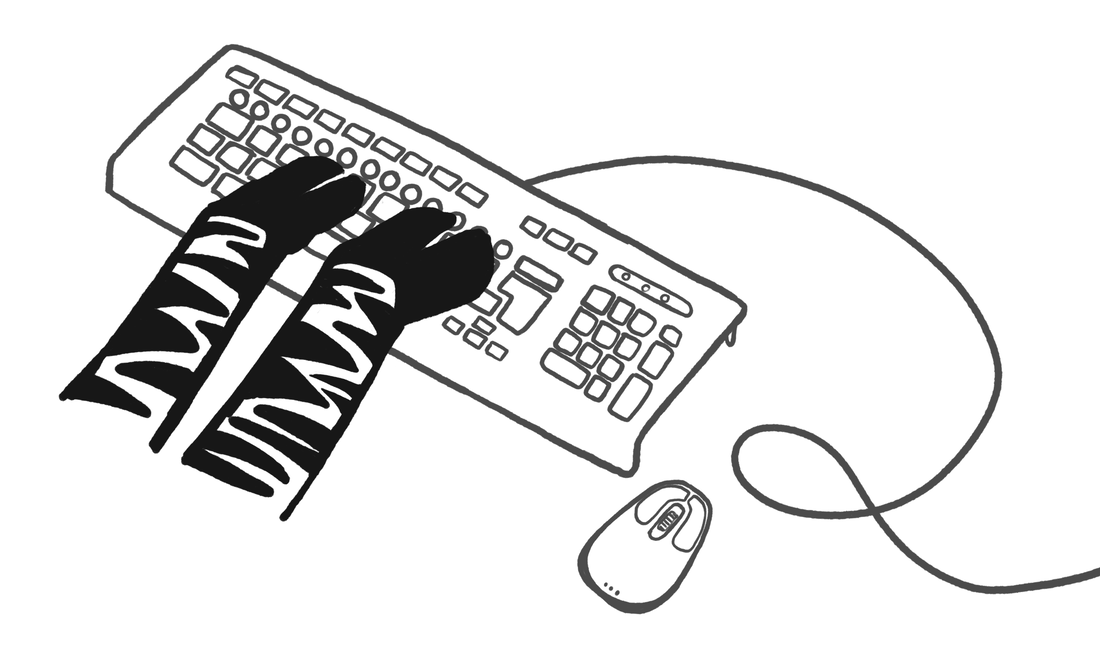A series of guest posts for Ehlers-Danlos, ME, Fibromyalgia, and Mental Health Awareness Month5/9/2019
It’s my hope to raise awareness of what living with CF is like, but more than that, to build an empathy around it. It’s our general practitioners, specialists, social networks and family who are the vital support system we rely on, to help us and give us strength when our illnesses threaten to overcome us or worse, become our singular identity. It’s important that this support system is informed, not mislead, and fully-equipped to support sufferers in the best ways possible. I’ve written a few articles about my disabilities, a couple of which are online: about the pressure to ‘succeed’ at work and the blatant disregard and lack of support for chronic illness sufferers in the workplace; and about the stigma around chronic pain and the toxic hero-worship of ‘recovered’ sufferers. I’ve also participated in a podcast with author and fellow fibromyalgia sufferer, Ever Dundas (which will be publishing sometime in the next month or so) about our experience of living with our illnesses, so do keep your eyes peeled for that too. I wanted to use this space to shed a little light on what exactly ME, Ehlers-Danlos Syndrome (EDS) and Fibromyalgia are, what they have in common, and how they affect sufferers. It’s important to highlight that no two people’s experience will be the same: in as much the same way that were are all unique, so is our experience of living with these illnesses, and what may work for one person, might not work for another. I’ll be doing a separate blog later about the various coping techniques I find helpful, and the (many) ways in which I mitigate my symptoms (pacing, anyone?) ME, Ehlers-Danlos Syndrome and Fibromyalgia So what is ME (Myalgic Encephalomyelitis, also known as Chronic Fatigue Syndrome) Ehlers-Danlos Syndrome and Fibromyalgia? Well, as with all of these illnesses, the classification, ‘syndrome’ encompasses a myriad of little-understood symptoms, which can affect sufferers profoundly, or not much at all, depending on the person. Predominantly though, sufferers live with crushing, constant fatigue that isn’t relieved with rest; muscle pain; and difficulty with mental processing, also known as ‘cog-fog.’ Due to the crossover symptoms and occurrences of these illnesses (co-morbidity) it can be hard to identify what’s going on and which illness is responsible for which symptoms. Testing and Assessment Ehlers-Danlos has thirteen sub-types, twelve of which can now be tested for, as they have an identified genetic marker. Severity exists on a scale, with Type 3, aka Ehler-Danlos Syndrome or Hypermobility Syndrome as it’s now classified (since March 2019) being the mildest form and the only one without a genetic marker, so far. It’s the type I have. It is assessed via a physical examination and a questionnaire. Fibromyalgia is also assessed by a physical examination, as is ME. It is advised that general practitioners carry out a blood-screening to rule out alternative causes before exploring any of these illnesses as a possible cause. I was checked for low vitamin D3, low B vitamins, low ferratin and my liver function was checked along with my thyroid. All fine, so it was off to the rheumatologist I went. Fibromyalgia My experience with NHS is a long, painful one. I think this seems to be the norm, unfortunately, but I will write about this in another post. I was referred to see a rheumatologist on two separate occasions, first when I was diagnosed with fibromyalgia and secondly with Ehler-Danlos Syndrome. They present many of the same symptoms, however fibromyalgia has specific ‘trigger’ points for pain which are part of its classification, keeping it separate from other illness classifications. (I see my illnesses as part of one, big umbrella of symptoms). I have about eleven pairs of these trigger-points (in a mirror-image, either side of your body) which when pressed with medium pressure become very sore, very quickly. Pain will often radiate down the body from these points when triggered, a bit like a musical string. I also suffer from intermittent IBS, migraine, muscle soreness and stiffness, and chronic fatigue, which is exacerbated after exercise (also a symptom of ME). Fibromyalgia = check. Helpful info: http://www.fmauk.org/ #spoonie #chronicpain #fibromyalgia #fibro Ehlers-Danlos Syndrome Ehlers-Danlos Syndrome also presents muscle pain, stiffness, headache, IBS, joint pain and chronic fatigue, with the added bonus of Postural Tachycardia Syndrome (POTS). It makes your heart leap out of your chest like a horse at the races every time you stand up or climb stairs or have a coffee (mine was horrendous when my chronic fatigue was at its worst, after I burnt-out spectacularly, two years ago). It makes life extremely difficult and you worry every time you move, your ticker is going to give-out. So yeah, that’s great. But EDS’ defining classification (like the trigger-points for fibro) is the presence of hypermobility in the joints. This can vary wildly from extreme (joints popping out of their sockets at will, several times a day) to mild (subluxations, cracking joints, and stretchy skin – like what I have). Essentially all three sub-types share a common denominator: poor collagen. We don’t make the right stuff, and we don’t hold together as we should. (I like to think of it as, you’re made with Super-Glue and I’m made with glue-stick, Tesco own-brand). Because of this, our joints are hypermobile and can bend to angles that just shouldn’t work. They don’t protect our muscles, therefore, from over-extending, and they get damaged. Hence the pain and stiffness. It’s important for an EDS sufferer to strengthen their muscles to protect them. Yoga and stretchy-shenanigans should only be approached under the guidance of an experienced, informed instructor, and only once a base-level of strength has been established. Pilates is your friend. Helpful info: https://www.ehlers-danlos.org/ #timetodiagnosis #invisiblevisible #EhlersDanlosAwareness #eds ME So that brings us to ME; a ‘diagnosis of exclusion’. It presents with all of the above symptoms, but it lacks the defining symptoms of fibro’s trigger-points, or EDS’ hypermobility. And it’s probably the least understood. However, research is picking up with some interesting preliminary findings. It’s a case of playing the waiting game. It comes out of the blue for many, often following infection or trauma. For others there is no discernible cause. Many sufferers are bed-bound, unable to even lift their head. In milder cases, if a sufferer can be physically active, such as walk about, they often experience and extreme level of fatigue which can last for days or trigger a flare-up lasting weeks or months, or in some cases years. https://www.actionforme.org.uk/ https://www.meassociation.org.uk/ #MEAwarenessWeek #MeAwarenessMonth #meawarenessday #MillionsMissing These are serious, life-long illnesses which hugely disable those who live with them. Because they are little understood, a stigma builds up against them, which is damaging to sufferers, to whom support and understanding is a key part of managing a disabled life. I write openly about my issues with my mental health, and the two are intrinsic to one another. When I’m having a pain flare, or my brain won’t work, my anxiety spirals, and I feel extremely depressed about my health. When it’s a good day, I find my mood is great and I feel positive and hopeful about the future. It’s an exhausting dance that we do, between two ends of a spectrum, daily. Just being chronically ill, and dealing with everything that comes with that, can make everything worse. It’s so important to have a strong community around us. To be told you are invalid because of your health (by society, employers, the benefit system) is utterly soul-destroying and it takes an enormous amount of strength to keep moving forward, researching different approaches and treatments, trying to find ways to continue to work (no thanks to our horrendous benefits system, I talk more about this in the upcoming podcast) and generally trying to find the light in every single (often dark) day. Several celebrities have recently opened up about living with their invisible, chronic illnesses, throwing much needed light onto the difficulties faced by sufferers: and importantly, smashing the stigmas that disabled people can't enjoy full and happy lives, and success. Just look at Lady Gaga, who lives with fibromyalgia, or Selma Blair, who has Multiple Sclerosis, or Natasha Ngan, who has EDS. All successful in their fields, all living day-in-day-out with disabling, chronic illnesses. David Grotty, Getty Images The rise of social media has seen a surge in online awareness campaigns such as #DisabledPeopleAreHot and #DisabledandCute which people are embracing all over the world, to empower, support and encourage people to speak out and build a community. Invisible illness even has it's own mascot — the zebra; symbolizing the rarity and uniqueness of chronic illnesses. We're told by our government that we aren't ill enough to be supported. By our society that we're not sick because we don't look it. We're told by our employers that we are a liability. We are told that we can't be sick, if we are successful. We must be fearless, like them, and shape our own narrative. I hope that the upcoming guest posts will resonate with you: either because you too, are going through it, living with it, struggling and surviving it; or because you know someone who is. We hear you, we see you, and we understand you. And our voices will be heard.
0 Comments
Leave a Reply. |
My latest writings, and thoughts on disability, mental health and young-adult lit. Archives
September 2022
|




 RSS Feed
RSS Feed